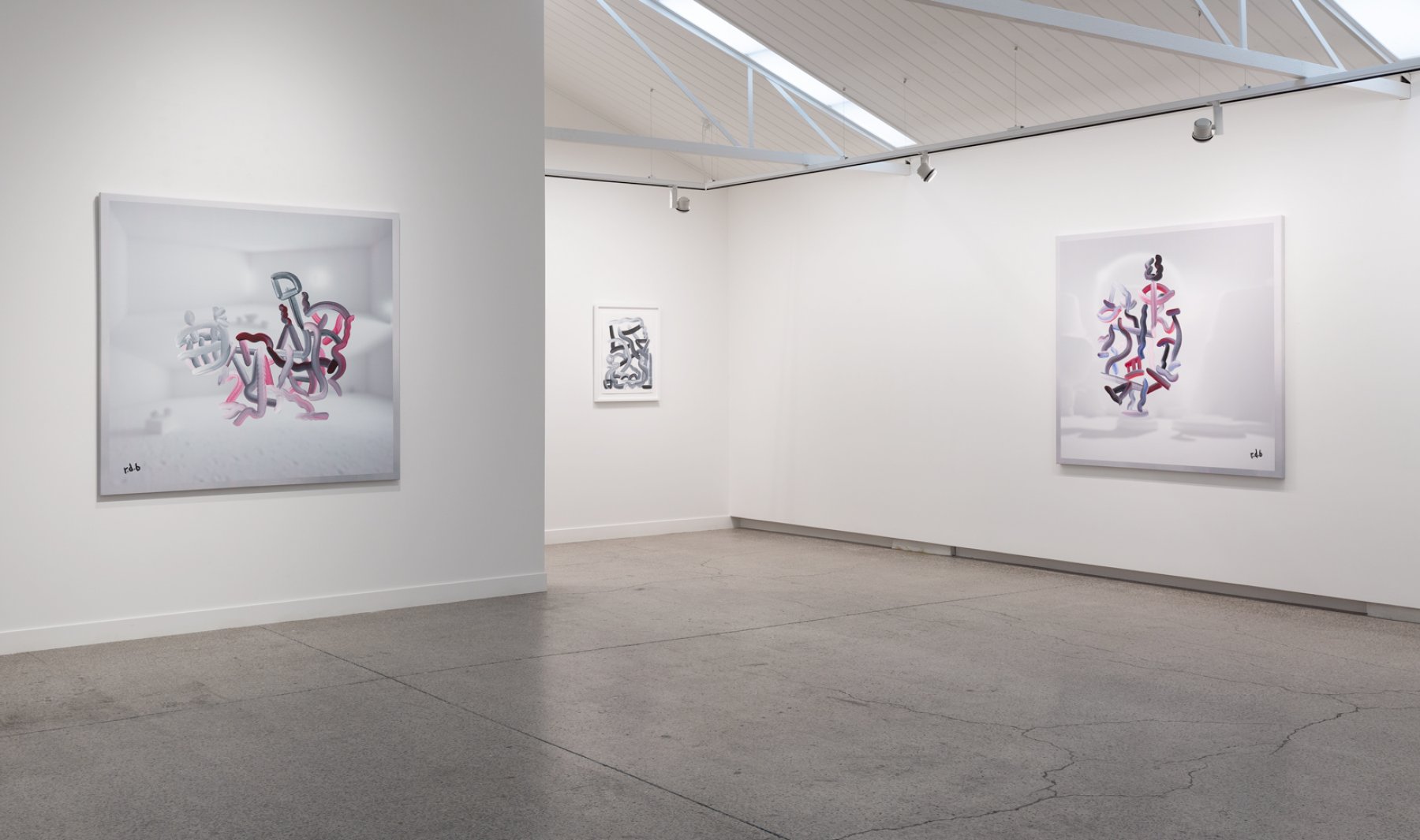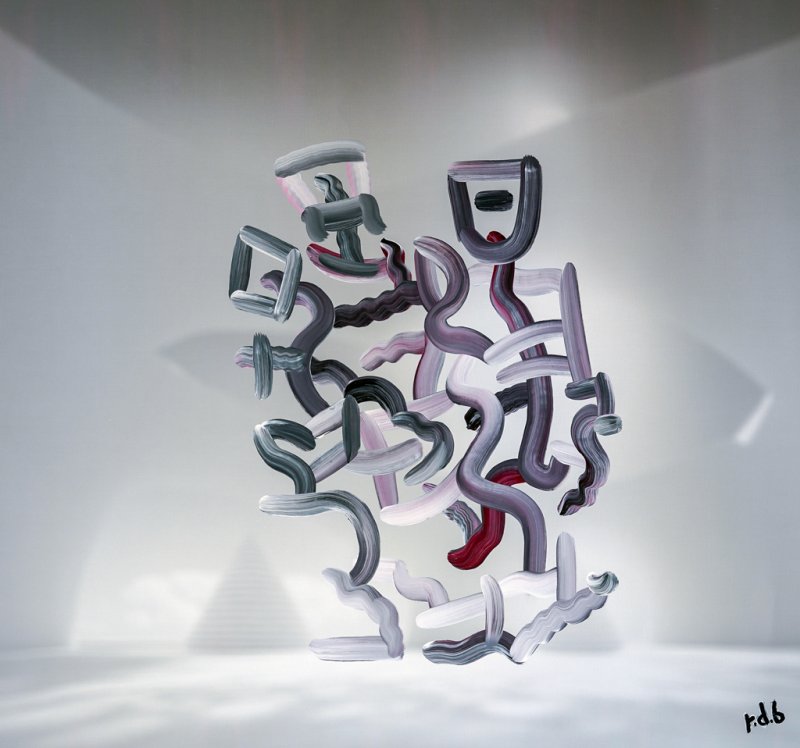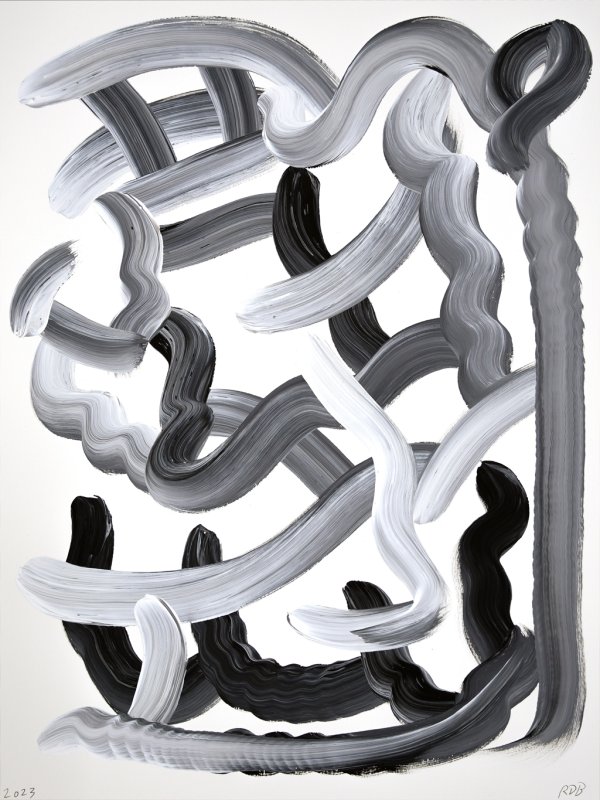The Mirror
EditorialAboutA+a Study CentreA+a ArchiveShopClose Menu

Over the past decade Ry David Bradley has explored, as Cameron Hurst highlights, 'the entwined possibilities of painting and new technologies'.1 His ongoing experimental project has taken on emerging software and printing formats to question what painting can be in the twenty first century. In the following discussion Jeremy Eaton and Ry David Bradley explore the development of his work and his return, in the face of AI, to the materiality of paint.
Jeremy Eaton (JE): You started considering the intersection of the digital and painting early on in your practice through your Master of Fine Arts (2012) at the Victorian college of the Arts. It appears you were looking for a twenty first century response (or update?) to an ancient tradition. Since then digital imaging technologies have developed rapidly. I can imagine technologies you once used are possibly now obsolescent. Can you walk us through some of the technologies you have employed in your work. What have you seen change and how it has effected your approach to making?
Ry David Bradley (RDB): It’s true that many things have changed since then, perhaps most noticeably the many art and exhibition websites that existed ten years ago to display and discuss this kind of work are now no longer online. Many of the artists from that time too have also moved on to other pursuits in life. It was for that reason that I valued painting, and the art object—because of it’s inherent ability to last through time, and to be kept by institutions and individuals who collect. Digital culture does not have a strong sense of its own preservation, it may even be somewhat anathema to this idea completely.
...The funny thing is software and imaging tools used to be quite specific to use and required hours of input, yet audiences sometimes assumed everything happened automatically with one click. While they were wrong then, they may now be closer to being right about that! It’s largely Hollywoods fault, perpetuating the “enhance” image command in almost every sci-fi film that was ever made. Yet the intuitive nature of AI tools and their implementation have meant that we are now able to produce things more professionally much faster. However, I still think what hasn’t changed, and what is perhaps always true for many things, is finding ones own unique process and pathway that is distinct. For that reason I still use many digital brushes I customised many years ago, to avoid the generic aesthetic we now see in many AI produced images.

JE: These digital brushes are indicative of a central aspect of your ongoing project. Even though you work at the forefront of digital imaging and art, there is a necessarily historical bent, as you have continued to position your work within the discipline of painting. What are some of the connections you have identified between contemporary technology, and a discipline that carries so much history?
RDB: I actually see most historic painting as photography, for most of its 600 year history it focused on capturing reality with techniques like the camera obscura—a person inside a dark room literally tracing the projected light from a pinhole or lens onto canvas. For this reason I’ve always broadly understood them both as types of image, and the digital is yet another way to that end. What happened to painting when the mechanical camera was invented was interesting, painting actually began for the first time ever to divert away from realism, and toward more intuitive and expressive means. The third great interruption to painting has been digital process, and exploring the boundaries of that has always been compelling to me. Nothing will replace anything, there are just more pathways as time goes on.
JE: One of the pathways that has emerged and one that you have explored is AI, as seen in your recent exhibition GEN exhibited at Sullivan + Strumpf. Even though some of these technologies have been available in a less accessible form for some time, their new approachable, natural language interfaces have seen them explode into the popular consciousness. When did you start working with this technology? Can you talk about the interfaces you were using and some of the processes you went through in the production of GEN?
RDB: An artist friend of mine Jon Rafman has been working with the developers of GAN and diffusion models for the last few years, as they underwent loads of iterations and improvements, which we talked about during it’s kind of early release in 2018. I got access to Stability a couple of years ago and started playing around with versions of my work, and then decided to try and work with it in a kind of duet. AI could construct the scene or environment, and I would paint within it. But instead of using software, I spent a lot of time studying flashe acrylic paint, as it dries very flat and was hard to detect against the print on linen that we made in Paris. There are many different models to use in the AI component, I could manually select the model and adjust lots of parameters on the outcome. I actually preferred some of the models from a few years ago to the very latest ones, sometimes the misunderstandings produced a bizarre beauty beyond usual human perspective.
JE: That’s interesting that you found the older models more generative artistically, as it seems current AI imaging platforms seem to have a flattening effect or as you have stated an ‘unnerving’ quality. How do you find your own stylistic sensibility within the programs’ constraints or are they more of a conceptual tool?
RDB: I agree there can be a very generic flattening with AI models that don’t allow any customisation. There are only a few tools now that allow access to earlier training sets and various settings to alter the output and steer it away from producing a kind of overpolished middle ground. It seems as if the errors the earlier models were producing are being phased out, yet it was precisely those that were able to manifest the most idiosyncratic and unexpected outcomes—which seemed like creativity. The more and more controlled the endpoint is, the more and more generic it begins to look. So hopefully access to variable controls and custom settings will always be possible in the rendering process. If not, it may be hard for humans to maintain control of contemporary aesthetics.


JE: A part of this control over aesthetics seems evident in your material choices and approaches in GEN. With some of your past work paint itself had evaporated into pixels as you used software to generate brushstrokes. In the instance of GEN, it is interesting that you have turned back to the materiality of paint to mimic the digital brushstrokes in your earlier work. It is almost as though painting has become so dematerialised in your work that it has necessarily rematerialised. Can you talk a bit about that decision and particularly the choice to use acrylic flashe in the paintings in GEN?
RDB: Exactly! I couldn’t have said it better myself. For some reason with the advent of so much digital imagery last year, I decided to challenge myself to mimic the round brush common to most digital painting programs as a physical process. The main thing that was most enjoyable about this practice was engaging with the slowness of the brush, I found that the best way to mimic the digital brush was to paint the stroke extremely slowly, almost printing it. But interestingly enough, a lot of the settings I use in software became a guide for how to work with acrylic, for example keeping the brush load at 100% and working wet into wet. Flashe itself is a French paint from the 1950’s that displays very high chroma colours and dries to a very flat finish, so it would almost merge with the print layer or even appear to sit slightly beneath it. I wanted the physical hand to merge with the digital layer in an illusionistic fashion. Going forward there will be many more experiments into these outcomes.
JE: And finally, what do you see as the possible issues and benefits of AI for painting moving forward and how is this manifesting in your future work?
RDB: Some issues with AI imagery have always been centred around how the AI models are trained, for example the datasets it uses may have often been built from the work of artists without their consent, and so some issues can arise around attribution and IP. But I’ve found that this mainly occurs when the prompt is too simple, and the best way is to actually guide the AI stems from using your own images as a training set, that way it can be led in a very specific direction with the right amount of input parameters. So the more focused it is, the more unique the outcomes. In a nutshell we are at another inflection point for visual possibilities in the 21st century. I guess in the end it’s always more interesting to be moving downstream than trying to swim back against the current.

1. Cameron Hurst, "Ry David Bradley: The GEN Turn", from Sullivan+Strumpf Contemporary Art Gallery Sydney, Melbourne & Singapore – Apr/May/Jun 2023, https://issuu.com/sullivanstrumpf/docs/aprmayjun2023/s/23269776
Author/s: Jeremy Eaton & Ry David Bradley
Jeremy Eaton & Ry David Bradley. 2023. “Paint Rematerialises.” Art and Australia 58, no.2 https://artandaustralia.com/58_2/p171/paint-rematerialises
Art + Australia Editor-in-Chief: Su Baker Contact: info@artandaustralia.com Receive news from Art + Australia Art + Australia was established in 1963 by Sam Ure-Smith and in 2015 was donated to the Victorian College of the Arts at the University of Melbourne by then publisher and editor Eleonora Triguboff as a gift of the ARTAND Foundation. Art + Australia acknowledges the generous support of the Dr Harold Schenberg Bequest and the Centre of Visual Art, University of Melbourne. @Copyright 2022 Victorian College of the Arts The views expressed in Art + Australia are those of the contributing authors and not necessarily those of the editors or publisher. Art + Australia respects your privacy. Read our Privacy Statement. Art + Australia acknowledges that we live and work on the unceded lands of the people of the Kulin nations who have been and remain traditional owners of this land for tens of thousands of years, and acknowledge and pay our respects to their Elders past, present, and emerging. Art + Australia ISSN 1837-2422
Publisher: Victorian College of the Arts
University of Melbourne
Editor at Large: Edward Colless
Managing Editor: Jeremy Eaton
Art + Australia Study Centre Editor: Suzie Fraser
Digital Archive Researcher: Chloe Ho
Business adviser: Debra Allanson
Design Editors: Karen Ann Donnachie and Andy Simionato (Design adviser. John Warwicker)
University of Melbourne ALL RIGHTS RESERVED
